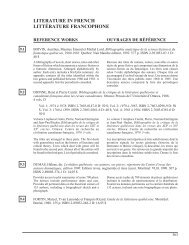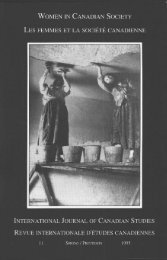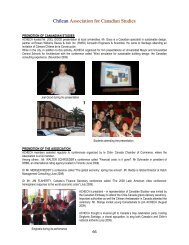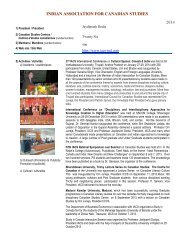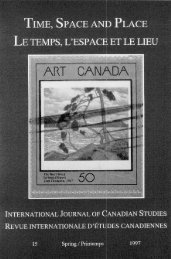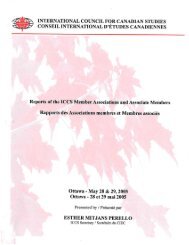Arts and Literature in Canada:Views from Abroad, Les arts et la ...
Arts and Literature in Canada:Views from Abroad, Les arts et la ...
Arts and Literature in Canada:Views from Abroad, Les arts et la ...
- No tags were found...
Create successful ePaper yourself
Turn your PDF publications into a flip-book with our unique Google optimized e-Paper software.
IJCS/RIÉCThe quotations referr<strong>in</strong>g to Nelly’s <strong>and</strong> Del’s childhood towns deserve closerexam<strong>in</strong>ation. Little need be said about the tell<strong>in</strong>g quality of the stre<strong>et</strong> names assuch. We perceive the all-pervad<strong>in</strong>g ideology of Nazi Germany’s arrogance,aggressive nationalism <strong>and</strong> belligerence manifest <strong>in</strong> Nelly’s hom<strong>et</strong>own <strong>and</strong>, <strong>in</strong>strik<strong>in</strong>g contrast to it, the homely stre<strong>et</strong> names of a peaceful Canadian townwhere only “Khartoum” (registered as “strange” by the perceptive child Del)echoes a distant battle-field. Both writers convey, with considerable verbaleconomy, a universal truth: to feel sheltered, a child needs to see order <strong>in</strong> thestructure of its world. Wolf’s “n<strong>et</strong>work of the stre<strong>et</strong>s [...] as the basic model”<strong>and</strong> Munro’s “order, wholeness, <strong>in</strong>tricate arrangement” evoke <strong>in</strong>terchangeablevisions. The rem<strong>in</strong>isc<strong>in</strong>g adult, however, needs to shift <strong>and</strong> edit <strong>and</strong> recreat<strong>et</strong>he past world <strong>in</strong> his/her quest for an <strong>in</strong>terpr<strong>et</strong>ation. People will alwaysre<strong>in</strong>vent their past lives, if such <strong>in</strong>ventions make present life more tolerable.Both Wolf <strong>and</strong> Munro reflect on this universal behaviour by mak<strong>in</strong>g theirprotagonists question their memory material: the child Nelly is proud of her“authentic memory” (MC 5), y<strong>et</strong> the adult woman, forty years older, feels“hampered by her unreliable memory” <strong>and</strong> has to resort to “Memory aids. Listsof names, sk<strong>et</strong>ches of the town” (MC 7 f.). But Nelly Jordan, realiz<strong>in</strong>g thatreconstruct<strong>in</strong>g the past is not the only problem, confesses: “It is <strong>in</strong>terest<strong>in</strong>g thatwe either fictionalize or become tongue-tied when it comes to personalmatters” (MC 8). The child Del “[...] had a freak memory. Learn<strong>in</strong>g a list offacts was an irresistible test [...]” (LG 56). Some twenty years <strong>la</strong>ter, whentry<strong>in</strong>g to make lists of the build<strong>in</strong>gs <strong>and</strong> stre<strong>et</strong>s <strong>in</strong> her hom<strong>et</strong>own, 13 the maturenarrator wistfully states: “The hope of accuracy we br<strong>in</strong>g to such tasks is crazy,heartbreak<strong>in</strong>g” (LG 210).The first person plural <strong>in</strong> the statements “we either fictionalize or becom<strong>et</strong>ongue-tied” <strong>and</strong> “the hope ... we br<strong>in</strong>g to such tasks is crazy” deserves closerattention. Who is to be <strong>in</strong>cluded <strong>in</strong> the “we”? Fellow narrators <strong>in</strong> texts ofsimi<strong>la</strong>r literary discourse? The communities <strong>in</strong> which the quasiautobiographicalnarrative is embedded? The read<strong>in</strong>g public at <strong>la</strong>rge, or maybea specific type of reader? In his critical study Der implizite <strong>Les</strong>er Wolfgang Iserrefers to a simi<strong>la</strong>r use of the first person plural: “In solchen Wendungen beruft[sich der Ich-Erzähler] auf Kollekiverfahrungen, die von allen Menschen g<strong>et</strong>eiltwerden können.” 14 In his <strong>la</strong>ter work, Iser has developed his theory of “impliedreader” <strong>and</strong> “actual reader.” 15 The concept of the “implied reader” refers to arole assigned to the reader by the structure <strong>and</strong> strategies of the text. It denotesa k<strong>in</strong>d of <strong>in</strong>termediate phase <strong>in</strong> the process of read<strong>in</strong>g which will eventuallyflow <strong>in</strong>to the consciousness of the actual reader, a s<strong>et</strong> of notions or mentalimages (“Vorstellungen”) that will <strong>in</strong>evitably be coloured by the respectivereader’s <strong>in</strong>dividual stock of experience (“Erfahrungshaushalt”). Applied to th<strong>et</strong>ype of quasi-autobiographical fiction represented by Lives of Girls <strong>and</strong>Women <strong>and</strong> K<strong>in</strong>dheitsmuster, Iser’s m<strong>et</strong>hod reveals an <strong>in</strong>terest<strong>in</strong>g aspect. Theconcept of implied <strong>and</strong> actual reader refers to a system of spatio-temporalorientation. The “here <strong>and</strong> now” of the implied reader <strong>and</strong> the “there <strong>and</strong> then”of the actual reader’s past experience d<strong>et</strong>erm<strong>in</strong>e the quality <strong>and</strong> <strong>in</strong>tensity ofeach <strong>in</strong>dividual act of read<strong>in</strong>g. In the case of first-person narration, such a68



